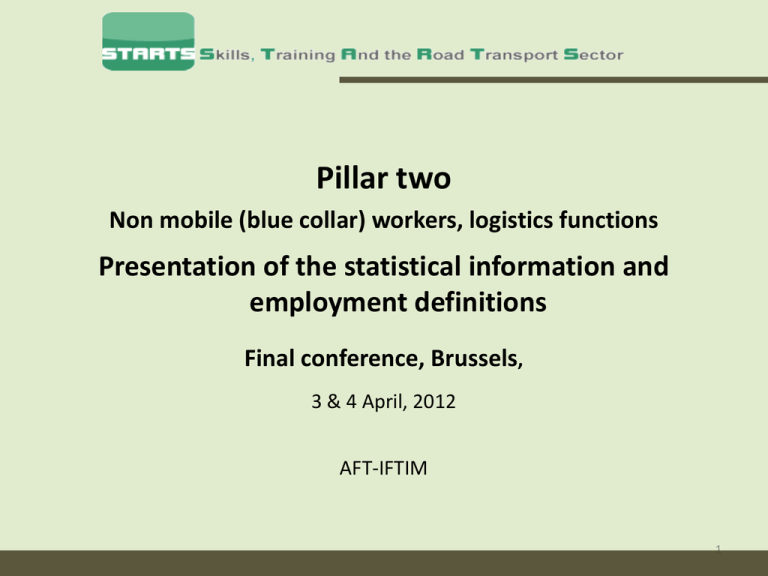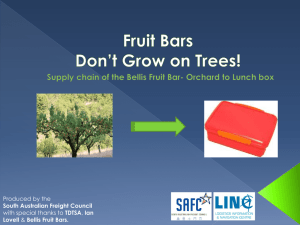Statistical information and employment definitions
advertisement

Pillar two Non mobile (blue collar) workers, logistics functions Presentation of the statistical information and employment definitions Final conference, Brussels, 3 & 4 April, 2012 AFT-IFTIM 1 Goals of the study Collection of job titles, descriptions and nomenclatures related to blue collar logistics workers in the freight road transport sector Statistical data and statistical nomenclatures related to blue collar logistics workers in the freight road transport sector Training provision related to the considered jobs Best practices identified in companies, training centres Methodology Questionnaire Road freight transport companies Training centres Descriptions of jobs Placement agencies, transport companies, training bodies, social partners Statistical data Statistical institutes, observatories, labour Ministries, labour agencies Reports, sector studies etc. Definitions of logistics jobs Statistical data The training offer and financing Identification of the targeted jobs according to the Novalog nomenclature Group 4 Warehousing The distinguishing feature of this group is that the jobs involve operational tasks carried out within a given amount of time, by monitoring using IT systems for constant control of the operations carried out, and by informing superiors of incidents and problems encountered. Warehouse Operations (blue collar) Warehouse Operator Forklift Driver Order Picker Freight transport by road Countries covered Austria Belgium Bulgaria Denmark France Germany Italy Lithuania Netherlands Czech Republic Portugal Romania Slovenia Spain Slovakia Difficulties in data collection A lack of willingness from the companies to involve in the survey – no time to dedicate to surveys, no direct benefits for the company… Poland: 63 companies, UK – 15 companies contacted by e-mail and recontacted by phone; Involvement of local partners and associations Result: impossible to convince companies in these countries to participate to interviews What statistical information available for quantifying jobs performing logistics functions in the sector of freight transport by road? The ISCO – a common tool Most of the national classifications in Europe are based on or harmonised with the international standard classification of occupations (ISCO, by the International Labour Office). Country National classification Version Austria ÖISCO 08 Belgium CITP 08 Bulgaria NCOD 08 Czech Republic KZAM 88 Denmark DISCO 08 Germany KldB 2010 Lithuania LPK 08 Portugal CPP 2010 Romania COR ISCO 08 Slovakia KZAM 2010 Slovenia SKP 08 Spain CNO 11 Targeted logistics jobs in the ISCO Group 4. Clerical support workers 4131 Stock clerks Stock clerks maintain records of goods produced and production materials received, weighed, issued, dispatched or put into stock. Subgroup 834 Mobile plant operators Slight differences between the two versions 88 and 08 of ISCO: ISCO 88 Lifting truck operators 8334 ISCO 08 Lifting truck operators 8344 Mobile plant operators drive, tend, operate and monitor special-purpose motorised, machinery or equipment used for clearing or preparing land; digging, moving, and spreading earth, rock and similar materials; and lifting or moving heavy objects. 8344 Lifting truck operators Lifting-truck operators drive, operate and monitor lifting-truck or similar vehicle to transport, lift and stack pallets with goods. Examples of the occupations classified here: - Forklift truck driver Source: http://www.ilo.org/public/english/bureau/stat/isco/isco08/index.htm Completed by the elementary occupations of group 9 Group 9: Elementary occupations Elementary occupations involve the performance of simple and routine tasks which may require the use of hand-held tools and considerable physical effort. Most occupations in this major group require skills at the first ISCO skill level. Related to the transport and logistics sector: 933 Transport and storage labourers Transport and storage labourers propel cycles and similar vehicles and drive animaldrawn vehicles to transport passengers or goods, drive animal-drawn machinery, handle freight and baggage and stock shelves The occupations in this minor group are declined as follows: 9331 9333 9334 Hand and pedal vehicle drivers Freight handlers Shelf fillers Relying on ISCO only includes some limits 1. Information is not always available by ISCO classification or not detailed. 2. The ISCO nomenclature is far from satisfactory for identifying logistics jobs. Level 1 of the ISCO-08 classification is the most aggregated, and therefore the least detailed. Logistics jobs targeted in the STARTS project may be identified within level 4. 3. Information collected on the basis of ISCO often provides only data on jobs at heavily aggregated levels of the nomenclature. As a consequence, wide-ranging job families can be quantified, but it is difficult to obtain updated data for logistics jobs. National approaches, ISCO correspondence Some countries have developed national (more detailed) classification of jobs, on the basis of which statistics are available. In France: the PCS nomenclature (list of professions and socio-professional categories) is at the centre of the system for identifying jobs, combined with broader interests than the mere production of data on jobs. PCS classification (Professions et catégories socioprofessionnelles) list is used by the national statistics body in coding population censuses, and in the survey on job structure. Sectors NAF The need to analyse jobs and unemployment by job led to the creation of a specific nomenclature of jobs (the FAP) constructed on the basis of the PCS and the operational repertoire (Répertoire Opérationnel des Métiers et des Emplois - ROME) used by the national employment agency (Pôle Emploi) to codify jobs to help jobseekers and employers make the right choices. NES36 NAF – French Nomenclature of activities NES – Synthesis economic nomenclature FAP – Nomenclature of professional families FAP PCS - Professions and socio-professional categories Level of qualification PCS ROME Occupations ROME – Operationnal Repertoire of Professions and Jobs Source: OREF Île de France National approaches, ISCO correspondence Germany also has its specific national classification of occupations Klassifizierung der Berufe: KldB 2010. Not based on ISCO, but a high comparable capacity of the last (2010) version. Data on labour market - Federal Employment Agency (Bundesagentur für Arbeit). Specific methodological approach, comparison of these statistical data with statistical employment data from other countries is difficult respectively not possible. Austria: statistical data on occupation - two different definitions: 1. according to international level comparable Labour-Force-Concept (ILO-definitions); 2. according to the national definitions set at the social security system (Hauptverband der Österreichischen Sozialversicherungsträger), i.e. reported data on occupations, and at the Austrian Public Employment Office (Arbeitsmarktservice Österreich - AMS). Nevertheless: statistical data on blue-collar worker working at the warehouse related to the road sector – not recorded at the responsible institution for the social security system (Hauptverband der österreichischen Sozialversicherungsträger) neither available to other institutions. Employment trends related to these occupations - provided by the Austrian Public Employment Office (Arbeitsmarktservice Österreich - AMS) within the AMSQualifikationsbarometer. Correspondence tables between the ISCO 08 and the national classifications have been elaborated, for a better comparability Logistics jobs definitions in the covered countries Main actors involved in logistics jobs definitions: Statistical and standardisation bodies Public employment agencies and placement agencies are developing increasingly comprehensive tools to help in pairing supply and demand and distribution of the definitions via Internet sites. The agencies participate in the renewal of the way logistics is considered in favour of more global approaches. The social partners: particularly at the sector level, but also jointly with other players (incl. training bodies). The social partners' contribution in defining logistics jobs is more present in countries of Western Europe. Training bodies, which use much broader categories in considering jobs in terms of full-length training courses; The road transport companies: usually rely on the definitions provided by the employment agencies and standardisation bodies, with some minor adaptations to the company’s specificities A variable number of institutions and heterogeneous aproaches in defining logistics jobs In Western countries (Belgium, France, Italy, Germany…) a variety of organizations are involved in the process of job definition and of matching the needs of the labour market to the provision of education and training. In countries with less developed collective bargaining (Romania, Lithuania, Bulgaria) the main source for job definitions is the ISCO system (Statistical institutes) and the data collected by the National Employment bodies: Labour Ministry, Employment Agencies. Previous occupational nomenclatures are harmonised with ISCO. Ex.: in Romania, the CNFPA (National Council for Training of Adults) contributes to the COR ( based on ISCO). Otherwise, job description is used for some collective bargaining. ISCO is the common classification for most of countries. France, Italy and Belgium have the widest variety of sources for job descriptions. Germany: a new classification in use since 2011, reflecting the changes within the professional occupations during the past decades. High comparable capacity has been generated to the International Standard Classification of Occupations 2008 (ISCO-08). Germany: development and structural design for KldB 2010 KldB 2010 The level of qualification needs (Anforderung sniveau) – the core principle of the design Level 1: Activities of unskilled worker/helper and apprenticeship (Helfer- und Anlerntätigkeiten) (simple routineous non-complex activities. 1 year of vocational education); Level 2: Subject oriented activities (fachlich ausgerichtete Tätigkeiten) (2-3 years of vocational education) Level 3: Complex activities of specialists (komplexe Spezialistentätigkeiten) (more complex than level 2; based on additional or periodic trainings or adequate professional experiences and/or informal vocational formation); Level 4: Highly complex activities (hoch komplexe Tätigkeiten) (very high degree of complexity. Min. of 4 years of academic education, adequate professional experiences); Federal Statistics Office Federal Employment Agency The German example: a statistical classification including a wide range of jobs related to the warehouse functions • • • • • • • • • • • • • • • According to KldB 2010 the following job titles are recorded for warehousing, postal delivery and goods transshipments (Lagerwirtschaft, Post und Zustellung, Güterumschlag): 513 Warehousing, postal delivery and goods transshipments (Lagerwirtschaft, Post und Zustellung, Güterumschlag) 5131 Professions at warehousing (Berufe in der Lagerwirtschaft) 51311 Unloader (Entlader/in) 51311 Helper for transport (Transporthelfer/in) 51311 Loader (Belader/in) 51311 Helper for production (Produktionshelfer/in Verpackung) 51311 Packer (Packer/in) 51311 Unskilled worker at the warehouse (Lagerhilfsarbeiter/in) 51311 Helper at the warehouse (Lagerhelfer/in) 51312 Warehouse worker (Fachlagerist/in) 51312 Skilled employee – warehouse logistics (Fachkraft Lagerlogistik) 51312 Disponent/at warehouse (Disponent/in Lager) 51312 Chief storekeeper (Magazinverwalter/in) 52531 forklift operator (Flurtransportgerätefahrer/in) Italy: an example of interaction for jobs definitions Italy : Example of job description For training purpose (orientaonline) Storekeeper/ Warehouse operator (Magazziniere) This figure has a role of technical and operational support and is present in all retailers and in wholesale trade. He is responsible for managing of incoming goods through handling and storage activities. In medium and large companies can also be found the profiles of staff for goods and goods auxiliary. He can check goods inbounds and outbounds and the accuracy of transport documents ("delivery note") and/or complete them using IT tools. He can load and unload the different means of transport and store goods in the warehouse, in general with mechanical means. He must, moreover, periodically check the quality of goods stored. In company: The goods reception specialist accomplishes the following tasks: • Receipt of goods: controls the matching between goods and goods description in the bills of lading • Inputing of goods within the company system and location in the warehouse • Goods labelling • Checking the location of goods in storage area (indicated by RF palmar device) • Preparing the loading (evening), after picking • Controls the composition of loads for deliveries Jobs definitions at the sectoral level Belgium: the “Fonds Social Transport et Logistique” (FSTL) is a security fund for companies of the sector of road transport and logistics. The board is constituted with parity of representation between employers and union organisations. The main activities are : - To manage some social benefits to the workers of the sector - The continuous vocational training of workers - The promotion and improvement of work condition and security in this sector. The “Institut Transport routier & Logistique Belgique” (ITLB): is a non profit association created by both authorities and private sector. The board is constituted with parity of representation between the Ministry of Transport and Mobility and professional organisations of road transport in Belgium (FEBETRA, SAV and UPTR). France: National collective agreement of the road transport and transport auxiliary activities (Convention Nationale des transports routiers et des activités auxiliaires du transport) contributes to setting up and approval of definitions of specific jobs of the personnel of companies providing logistics services. Example: handler in logistics (manutentionnaire logistique), logistical agent (agent logistique) 20 Jobs definitions at the sectoral level Netherlands: the Dutch organisation for the valuation of functions in road freight transport and mobile cranes (FUWA wegvervoer) elaborates and publishes a handbook on transport and logistics functions and types of jobs. It describes the functions according to six aspects: • [a] knowledge and experience, • [b] self-dependence, risks, responsibilities and influence, • [c] social skills and communication skills, • [d] skills in handling equipment and tools and attentiveness, • [e] burdening circumstances. And distinguishes four categories of functions: [1] drivers, [2] logistical functions, [3] technical functions, [4] planning / commercial / supporting / accounting functions. The handbook contains an extended list of job descriptions. The group of job descriptions that describes non mobile blue collar logistics jobs is “group 10” : • order picker (A), logistics operator (B), warehouse operator (C), reach truck driver (C), warehouse foreman (D), inventory management operator (D), clerk (E), warehouse team leader (E), The letters (A) - (G) refer to the scaling categories which are used to determine the salaries. (A) is the lowest category and it requires the lowest level of schooling, diplomas and skills. (H) is the highest, but 21 it does not exist in the logistical group of functions. Inputs from companies – jobs titles in use Most common terms in the interviewed companies: • • • • • Handler Order picker Forklift driver, forklift operator Foreman, shift leader Warehouseman For smaller companies (flat structures), larger definitions which designate multitask personnel: • store worker, • warehouse employee, • terminal employee. Inputs from companies - recruitment The inputs coming from the companies are essential in order to provide a relevant up to date nomenclature of job definitions related to the logistics functions and to select the relevant commonly interprofessional job definitions available. The definitions of logistics jobs in the company are strongly correlated with the size of the company. Bigger is the company, more hierarchical is its structure and more clearly delimitated the functions. Main recruitment criteria: • • • • • motivation; previous experience; physical condition; age – 40-45 years maximum teamplayer Inputs from companies - competences Most common competences valued by the interviewed companies: • Knowledge of the national language – written and spoken; • Good physical condition, stress resistant, ability to meet deadlines; • Basic knowledge of a foreign language; • PC user skills; • Ability to handle heavy loads correctly, good orientation in a closed space; • Awareness of safety rules in a warehouse; • Autonomous, multi-task, responsiveness; • Knowledge of the goods stored in the warehouse; • Team player, communicative • Knowledge of a foreign language – an advantage Inputs from companies Aspects of training underlined: • Health and safety rules • Gestures and postures for handling heavy loads and operating equipment in a warehouse; • Fire prevention; • First aid Recent changes and trends: • An increasing automation of processes, which decreases the number of human errors in the processes but requires more technological skills; • The growing importance and use of IT; • Less paper support, an increasing use of mobile devices; • Growing importance of foreign languages (English). A complex reality with a broad variety of possible combinations of activities Multi-task W a r eh o u s e function Specialised by tasks Unskilled warehouse worker Handler-forklift driver Warehouse worker/operative Forklift driver Store worker Storage and Terminal employee Handler Warehouseman-forklift driver Order picker Terminal employee Terminal worker + supervision Team leader Foreman Area responsible Warehouseman Platform agent (agent de quai)









